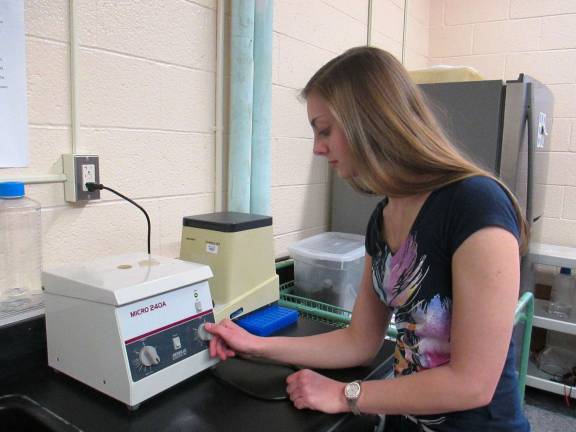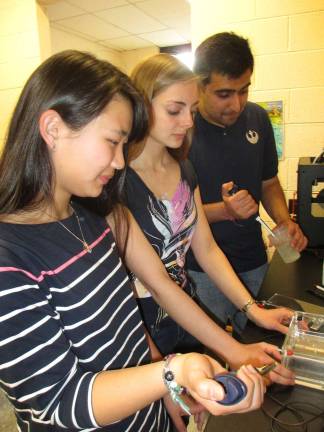High Point students take lead in genetic barcoding


SUSSEX BOROUGH — High Point Regional High School student Brinley Burdge believes the research she and several other students have been doing can change lives.
Madelaine Travaille has been a science teacher at High Point since 2004. Recognizing an interest in her students to study the subject, Travaille helped create a hybrid-virtual course in 2012 called Introduction to Research in Molecular Biology. She also runs an Advanced Science Research independent study class for students who wish to conduct independent research experiments of their own design.
In the beginning of the school year, Travaille introduced the world’s largest biodiversity genomics project to her students: Barcoding Life’s Matrix. Hosted by Coastal Marine Biolabs located in Ventura, Calif., with funding support from the National Science Foundation, the program allows high school students to join the global effort in, as Travaille puts it, “creating a DNA barcode reference library for all multi-cellular life.”
“My students have had the opportunity to publish their data to the Coastal Marine Biolabs Student Data Portal-Barcode of Life database,” Travaille said.
The (iBOL) International Barcode of Life project was formally launched in October 2010 with the goal of creating 5 million reference barcode records by 2015.
Seniors Catherine Henckel of Sussex and Burdge of Lafayette are students in the Advanced Science Research independent study class which, according to Travaille, will be an actual hybrid-virtual course next year called Advanced Science Research.
“Coastal Marine Biolabs provided us with the materials and reagents necessary to complete the DNA Barcoding laboratory work of 20 fish tissue samples,” Travaille said.
The first publications by Dr. Paul Hebert, director of the Biodiversity Institute of Ontario at Guelph University, that proposed DNA barcoding appeared in 2003.
“They are trying to catalogue every species on earth,” Travaille said, “I wanted my students to be a part of that.”
“DNA barcoding holds many practical uses,” Travaille said, “but proving whether or not you’re getting the expensive food you ordered in a restaurant is one example. Some restaurants have been known to cut up pig intestine — which has the same texture as calamari — and serve it to people pretending it’s the squid. People can’t tell the difference and are getting cheated out of their money.”
Classroom Close-Up — a 30-minute weekly series now in its 18th season that focuses on innovative projects happening in New Jersey public schools and airs on NJTV — visited High Point last October to highlight the school as the first in the state to participate in the Barcoding Life’s Matrix program.
On top of that, Travaille’s students were featured on the (MarBol) Marine Barcode of Life Initiative Blog in March in an article posted by Dirk Steinke, the director of Education and Outreach at Guelph University’s B.I.O.“Not many students at both the high school and college levels receive that opportunity,” Travaille admits. “The students feel like they’re making a difference with the knowledge that their data is helping scientific research. 16 students were involved, and each student published at least one sample.”
Travaille’s students also participated in the Waksman Student Scholars Program at Rutgers University, which focuses on the genomic sequence analysis of the Duckweed Landoltia punctata and how the genes in this organism compare with those of other species. Their data gathered here will be published to the (NCBI) National Center for Biotechnology Information database.